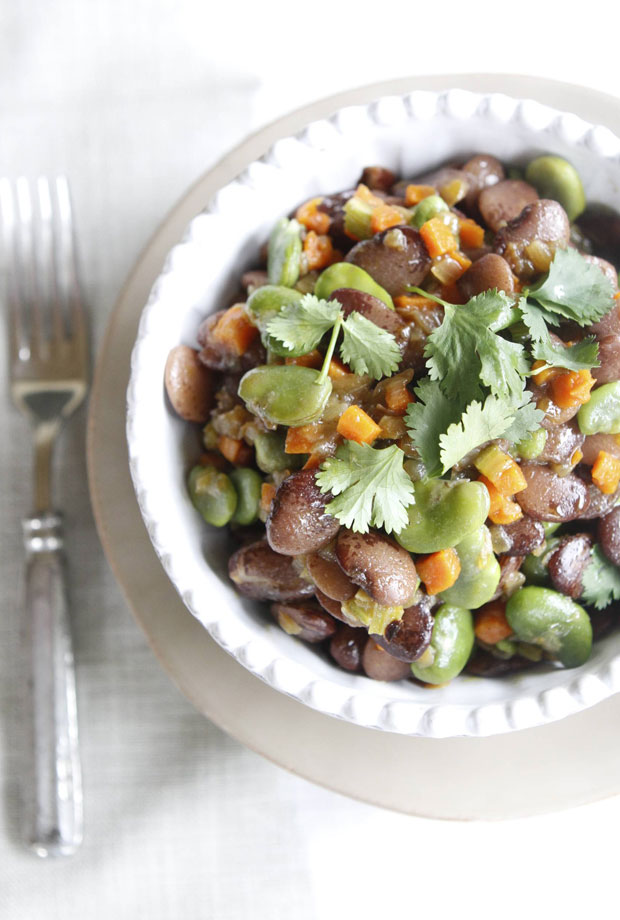May 23, 2014

Remember my trip to Blackberry Farm this past winter? One of the many great parts of the trip was taking a cooking class with the executive chef of Blackberry Farm, Joseph Lenn. Not only is Joseph incredibly knowledgeable, he’s the epitome of Southern charm —a total sweetheart of a man and completely modest. He showed us a few different recipes that day but my “aha moment” was a tip he slipped in saying to add the sofrito at the end of cooking rather than starting it as your base. What the what, really? ?
In Italian and Spanish cooking most sauces for braised meat will start with sautéing a mix of finely chopped carrots, celery and onion for a good twenty minutes. Benedetta Vitali told me there is a badge of honor for Italian home cooks marked by the effort and time you put into the process of your sofrito. It takes time and care to get that prized dark golden, but not burned, sofrito. This base adds incredible flavor and depth to whatever you’re cooking, but often gets covered up by the later addition of stock or protein.
In light of Joseph’s tip, I cook these beans not in the sofrito but along side of it. At the end, I drain the beans of most of their juices and add them to the sofrito and serve. With that simple switch-up the humble sofrito becomes the star of the show. I guarantee this is a delicious side dish for any table — especially served alongside that tri-tip from Tuesday.
You can use any type of bean for this dish. I’ve used cranberry beans, butter beans, cannellini beans, as well as large, white lima beans. Depending on which bean you go with your cooking times with vary, so check-in as you cook ‘em to get your desired consistency. Here, I added in some fresh fava beans, because it’s spring, we just harvested a basket and they’re so darn pretty.
*If you have any leftovers, puree them into bean dip to serve with veggies — add a splash of lemon and a drizzle of olive oil and maybe just a sprinkle of cayenne pepper and you’re in business!
Serves 6 – 8
Note: The fresher your beans are the less time they need to cook. Shop at a store that has a good turnaround of their dry goods — just because beans are dried doesn’t mean they should be old.
8 ounces dried beans of your choice (see above)
2 bay leaves
1/4 cup olive oil
1 tablespoon plus 1 teaspoon salt, divided
2 large carrots, small dice
2 large celery ribs, small dice
1 large yellow onion, small dice
3/4 cup fresh fava beans, peeled (optional)
Garnish with fresh herbs and a good quality olive oil. I like cilantro or parsley.
Wash your beans in a bowl of water removing any grit or pebbles. Next, soak the beans for 20 minutes on your counter in cool water while you prepare your chopped veggies.
(The longer you soak the beans, the shorter time they need to cook. I’m not one to soak for very long, way too impatient, but twenty minutes will be fine.)
In a large stockpot, cover soaked beans with water by two inches and add the bay leaves. Bring to boil and simmer until the beans are done cooking — usually about 1 hour (remember to check-in along the way).
Meanwhile, add your oil and diced veggies to a large skillet with 1 tsp of salt and cracked black pepper. Sauté on medium heat for at least 20 minutes, 30+ is optimal. Have some water on hand in case things get a little crazy and start to brown too quickly. The longer you cook the sofrito the more flavor you will give those beans.
Check on your beans periodically and just before they’re done cooking (when they are still a tad toothsome) add one tablespoon of salt. If you add the salt too early it will make the beans shrivel up and the skin loosen. Taste for seasoning — you might have to add a bit more salt. Reserve 1/2 cup of the bean cooking liquid, add the beans to the sofrito (and the fava beans here too, if using) and then add the cooking liquid as needed.
Garnish with a good drizzle of olive oil and fresh cilantro or parsley. Serve.